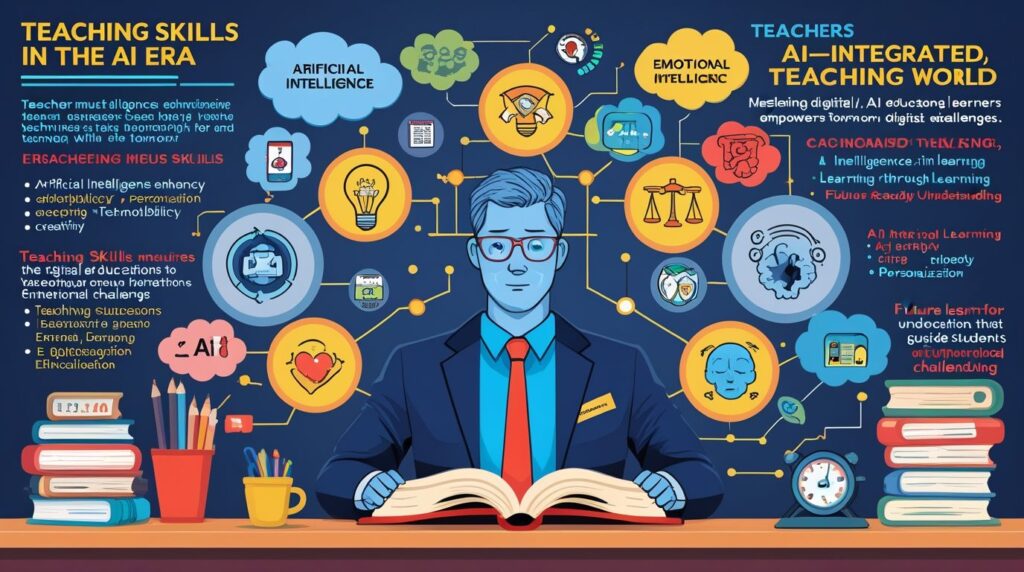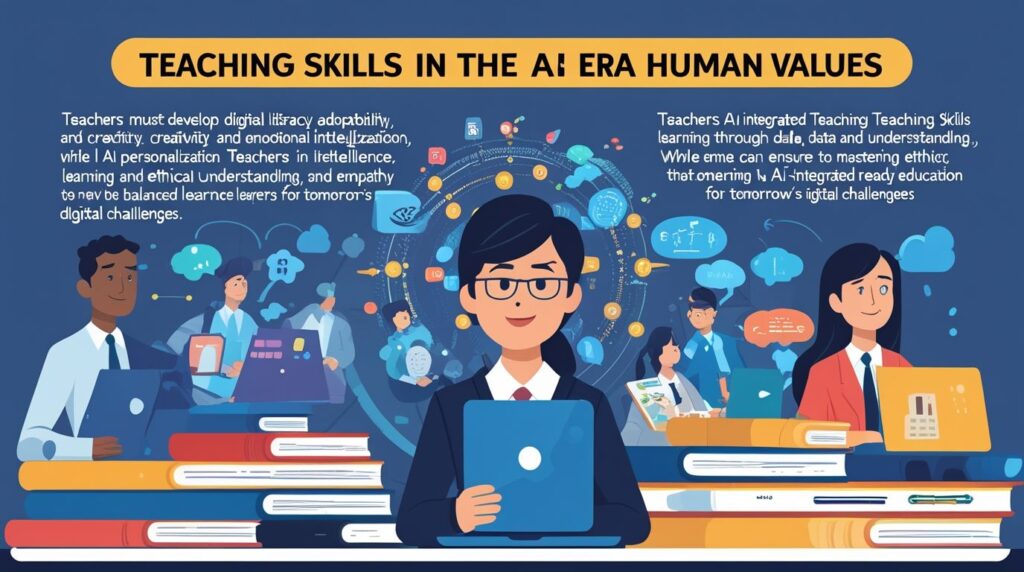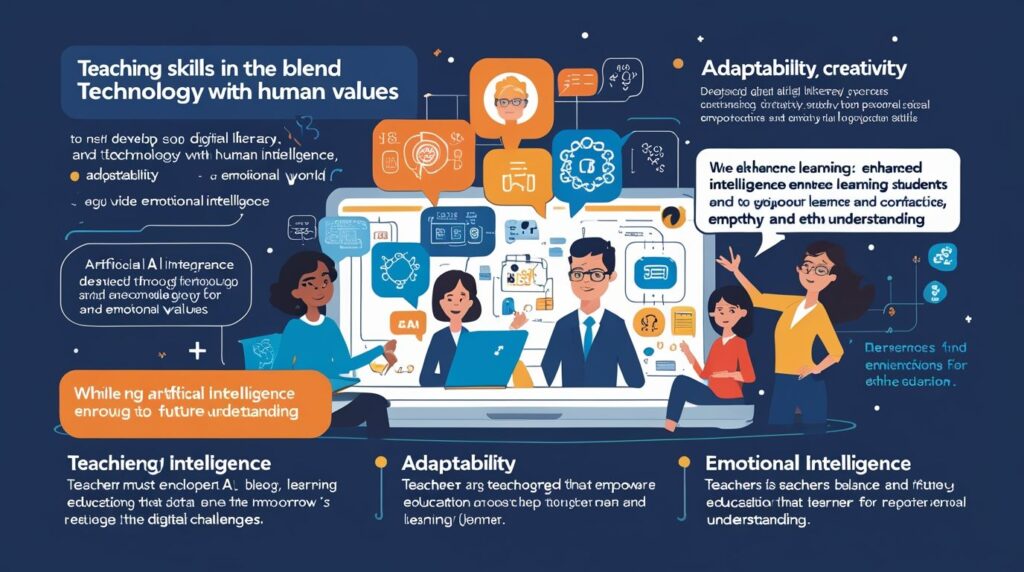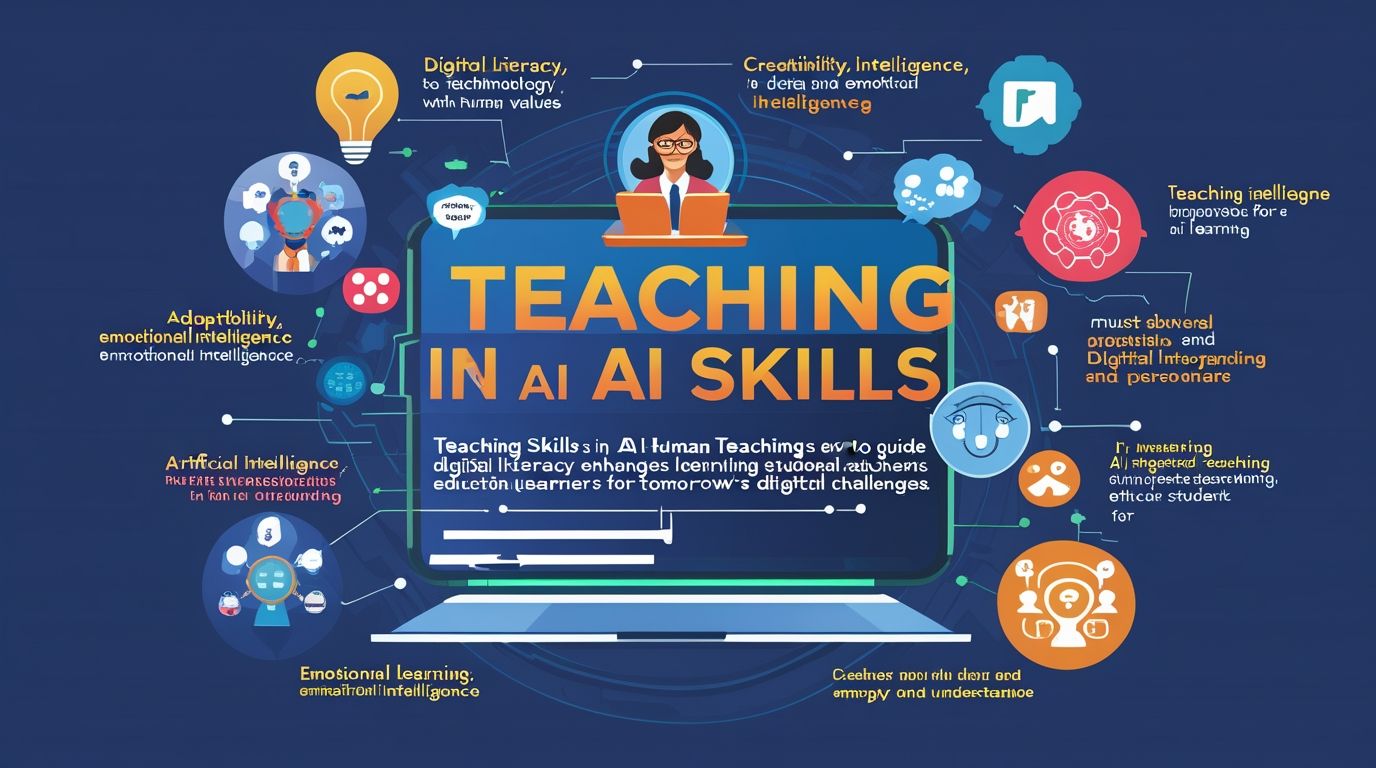Introduction:
Teaching Skills in the AI Era, In the AI era, the landscape of education has transformed dramatically. Teachers are no longer the sole providers of information; instead, they have become facilitators of learning in technologically enriched environments. Artificial intelligence brings tools that personalize instruction, analyze performance, and predict learning outcomes. Yet, these advancements also demand that teachers acquire new teaching skills. They must balance digital tools with emotional intelligence, creativity, and ethical understanding. Moreover, as AI becomes part of classrooms, teachers must learn how to integrate it responsibly and effectively. In this dynamic era, teaching skills go beyond traditional lesson delivery. They now encompass technological literacy, adaptability, critical thinking, and a deep understanding of human-AI collaboration. This evolution signifies that while machines can automate processes, only educators can humanize learning. Therefore, teaching in the AI age requires mastering the art of combining technology with compassion and vision.
Understanding the AI Transformation in Education
The AI transformation in education is not just a technological shift but a pedagogical revolution. Artificial intelligence supports teachers through automated grading, personalized learning systems, and intelligent tutoring programs. These innovations save time and offer tailored educational experiences for students. However, this transformation also challenges educators to redefine their teaching approaches. Teachers must interpret data insights from AI systems and translate them into effective instructional strategies. With AI handling repetitive tasks, teachers gain more time for mentoring, creativity, and emotional support. The classroom thus becomes a hybrid environment, where technology assists but does not replace human guidance. Understanding this transformation helps teachers identify which skills remain uniquely human—such as empathy, critical reflection, and ethical reasoning. Therefore, embracing AI is not about competing with technology but collaborating with it to enhance educational outcomes and create an inclusive learning environment.
Critical Thinking and Problem-Solving as Core Skills
In the AI era, the ability to think critically is more essential than ever. Since artificial intelligence handles information processing and data analysis, students must learn to interpret, evaluate, and make decisions based on AI-generated insights. Teachers play a key role in developing these critical thinking skills. They must encourage inquiry-based learning, where students question assumptions and analyze multiple perspectives. Furthermore, problem-solving remains a vital human skill that AI cannot fully replicate. Teachers should design real-world challenges that push learners to apply creative reasoning rather than rely solely on algorithms. By integrating AI tools like simulations or predictive models, educators can enhance students’ analytical capabilities. Still, human judgment and ethical evaluation are indispensable. Therefore, teaching critical thinking and problem-solving empowers learners to use AI as a tool for innovation rather than a crutch for thinking.

Digital Literacy and Technological Competence
In the AI-driven classroom, teachers must possess strong digital literacy and technological competence. Digital literacy goes beyond knowing how to operate devices—it includes understanding data ethics, algorithmic biases, and digital safety. Teachers need to guide students on how to use AI responsibly and discern reliable digital content. Moreover, they should be comfortable using AI-based educational platforms, data dashboards, and virtual learning environments. These tools help personalize instruction and track learning progress in real time. As digital natives, students expect teachers to integrate technology seamlessly into lessons. Therefore, educators must continuously upgrade their digital skills through workshops, online training, and peer collaboration. When teachers demonstrate technological confidence, they inspire students to use digital tools creatively. In short, digital literacy in the AI era is not optional; it is a core teaching skill that ensures effective and ethical use of technology in learning.
Adaptability and Lifelong Learning Mindset
Adaptability is the foundation of success in the AI era of education. Since technology evolves rapidly, teachers must embrace lifelong learning as part of their professional identity. They need to stay updated with emerging tools, software, and pedagogical strategies that integrate AI. Moreover, adaptability helps educators handle unexpected challenges, such as remote learning or hybrid teaching models. The willingness to learn, unlearn, and relearn ensures that teachers remain relevant in a constantly changing world. This mindset also serves as a model for students, showing them that learning never stops. By attending digital conferences, enrolling in online courses, and collaborating with tech-savvy peers, teachers can sharpen their adaptability. In essence, lifelong learning is not just about acquiring new knowledge—it’s about maintaining curiosity and resilience in an ever-advancing educational landscape shaped by artificial intelligence.
Emotional Intelligence and Human Connection
Despite AI’s analytical capabilities, it cannot replicate emotional intelligence—the core of effective teaching. Teachers must nurture empathy, communication, and understanding to create supportive learning environments. In the AI era, students interact with digital systems, but they still crave emotional connection and guidance from teachers. Therefore, educators should balance AI-driven tools with genuine human care. Emotional intelligence helps teachers identify students’ feelings, adapt their teaching accordingly, and foster motivation. Furthermore, AI may predict learning gaps, but only human teachers can address the emotional and psychological needs behind them. Building emotional resilience and social awareness prepares students to navigate both technological and personal challenges. Hence, emotional intelligence complements artificial intelligence, ensuring that technology enhances rather than replaces the human touch in education. It reminds us that teaching is a deeply human profession, even in the digital age.
Collaboration and Interdisciplinary Teaching
The AI revolution in education demands a collaborative mindset. Teachers can no longer work in isolation; instead, they must collaborate with peers, technologists, and researchers. Interdisciplinary collaboration helps integrate subjects like science, technology, arts, and humanities through AI tools. For instance, an English teacher can work with a data analyst to explore AI-generated language models, while a math teacher collaborates with computer scientists to analyze real-world datasets. These collaborations expand learning horizons and encourage creativity. Furthermore, collaborative teaching helps share best practices for using AI ethically and effectively. Through professional learning communities, teachers can exchange experiences about digital pedagogy. Collaboration also promotes inclusivity by bringing diverse perspectives together. Ultimately, interdisciplinary teaching enables educators to design more relevant and engaging lessons. As AI connects multiple fields, teachers must connect with one another to shape a more integrated and innovative education system.

Ethical Awareness and Responsible AI Use
With AI’s growing influence in classrooms, teachers must cultivate ethical awareness and promote responsible technology use. Artificial intelligence can collect, process, and analyze large amounts of student data, raising concerns about privacy and bias. Educators need to understand these risks and guide students on how to use AI tools ethically. Moreover, they should ensure that AI-based grading or assessment systems remain transparent and fair. Ethical teaching involves discussing digital citizenship, data protection, and algorithmic accountability. Teachers must model integrity and critical evaluation of AI-generated content. By embedding ethics into AI education, they prepare learners to use technology for social good rather than manipulation. Ethical awareness also involves questioning who designs AI systems and whose values they reflect. Therefore, teaching ethics alongside technology ensures that AI enhances education while preserving human dignity and fairness.
Creative Teaching with AI Tools
Creativity remains one of the most important teaching skills in the AI era. While machines can process data, only humans can imagine, innovate, and inspire. Teachers must use AI as a creative partner to enhance lesson design, storytelling, and student engagement. For example, AI-powered art generators, virtual simulations, and adaptive learning games can make lessons more interactive and enjoyable. However, educators should ensure that technology amplifies—not replaces—human imagination. Creative teaching involves blending traditional pedagogies with AI innovations to achieve deeper understanding. By encouraging students to use AI tools for creative expression, teachers prepare them for future careers requiring both innovation and digital fluency. Moreover, creativity fosters adaptability and curiosity, qualities essential in the digital age. In short, AI-powered creativity in teaching transforms classrooms into spaces of exploration and imagination, where learning becomes a dynamic and enjoyable experience.
Data-Driven Decision Making in Teaching
In the AI era, data has become a valuable educational resource. Teachers can use AI-generated insights to make data-driven decisions that improve learning outcomes. Learning analytics tools track student engagement, progress, and comprehension levels, helping educators tailor instruction accordingly. However, interpreting this data requires skill. Teachers must learn to translate analytics into actionable teaching strategies. For example, if AI reveals that students struggle with a specific topic, the teacher can redesign lessons to address those gaps. Moreover, data-driven teaching supports personalized learning, ensuring that every student receives appropriate support. Still, it’s important to balance quantitative data with qualitative understanding, as numbers cannot fully capture human experiences. By developing data literacy, teachers become strategic decision-makers. Therefore, combining AI analytics with human insight leads to more effective teaching and meaningful student learning experiences.
Blending Traditional and AI-Based Pedagogies
Successful educators in the AI era know how to blend traditional teaching methods with AI-based innovations. Traditional pedagogy emphasizes discussion, storytelling, and moral development, while AI tools focus on personalization and efficiency. By combining both, teachers create a balanced approach that values human connection alongside technological advancement. For instance, an AI tutor can handle repetitive drills, while the teacher focuses on creative projects and emotional guidance. This blend encourages active learning, where students apply knowledge through practice and reflection. Moreover, integrating AI with traditional pedagogy respects cultural diversity and individual learning styles. Teachers must ensure that technology complements rather than dominates classroom interactions. Hence, the most effective teaching strategy involves human-AI synergy, where digital intelligence supports—but never replaces—human creativity and empathy. This balanced approach ensures that education remains both progressive and deeply human-centered.
Professional Development in the AI Era
Continuous professional development is essential for teachers to thrive in an AI-driven educational world. Since technology evolves rapidly, teachers must engage in ongoing learning to stay competent and confident. Workshops, online certifications, and collaborative projects help educators acquire new digital skills and pedagogical techniques. Schools and educational institutions should support this growth by offering structured AI training programs. Furthermore, professional development promotes teacher leadership, empowering educators to guide others in technology integration. As teachers become more digitally fluent, they can innovate within their classrooms and share insights with peers. Additionally, reflective practices and mentorship programs encourage the exchange of ideas about AI ethics, learning analytics, and creativity. Ultimately, continuous learning enables teachers to adapt to the evolving educational landscape. Professional development in the AI era ensures that educators remain not only technologically skilled but also inspired to teach with purpose and innovation.

Challenges in Teaching during the AI Era
While AI offers remarkable advantages, teaching in the AI era also presents significant challenges. One major concern is the digital divide, as not all students or schools have equal access to AI tools. Teachers must find creative ways to ensure inclusivity and fairness. Additionally, over-reliance on AI may reduce critical thinking or creativity if not balanced with human guidance. Teachers also face difficulties in maintaining data privacy and security, as AI systems often collect sensitive information. Moreover, the pace of technological change can overwhelm educators who struggle to keep up. To address these issues, schools need clear policies, ethical standards, and adequate training. Teachers must also practice digital mindfulness—using AI thoughtfully rather than excessively. Overcoming these challenges ensures that technology enhances education without diminishing its human values. Thus, the success of AI integration depends largely on teacher preparedness and ethical awareness.
Conclusion: Teaching for the Future
Teaching in the AI era represents both a challenge and an opportunity. It calls for a redefinition of teaching skills, combining digital competence with emotional depth and ethical reasoning. Teachers must master technological literacy, foster creativity, and model lifelong learning. At the same time, they must nurture empathy, collaboration, and human values that AI cannot replace. The future of education depends on educators who can integrate AI not as a substitute for teaching but as a partner in learning. Therefore, the teacher of the future is not one who competes with technology but one who guides its use responsibly and creatively. By embracing innovation while preserving humanity, teachers can prepare students to thrive in a world where artificial and human intelligence work together to build knowledge, understanding, and a better society.
References
- Holmes, W., Bialik, M., & Fadel, C. (2019). Artificial Intelligence in Education: Promises and Implications for Teaching and Learning. Boston: Center for Curriculum Redesign.
- Luckin, R. (2018). Machine Learning and Human Intelligence: The Future of Education for the 21st Century. UCL Institute of Education Press.
- UNESCO. (2023). AI and Education: Guidance for Policy-makers. Paris: UNESCO Publishing.
- OECD. (2021). AI in Education: Challenges and Opportunities for Teaching. Paris: OECD Education Policy Papers.
